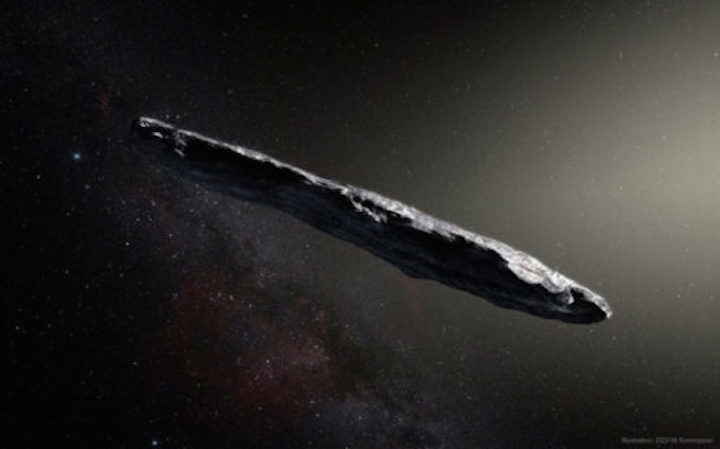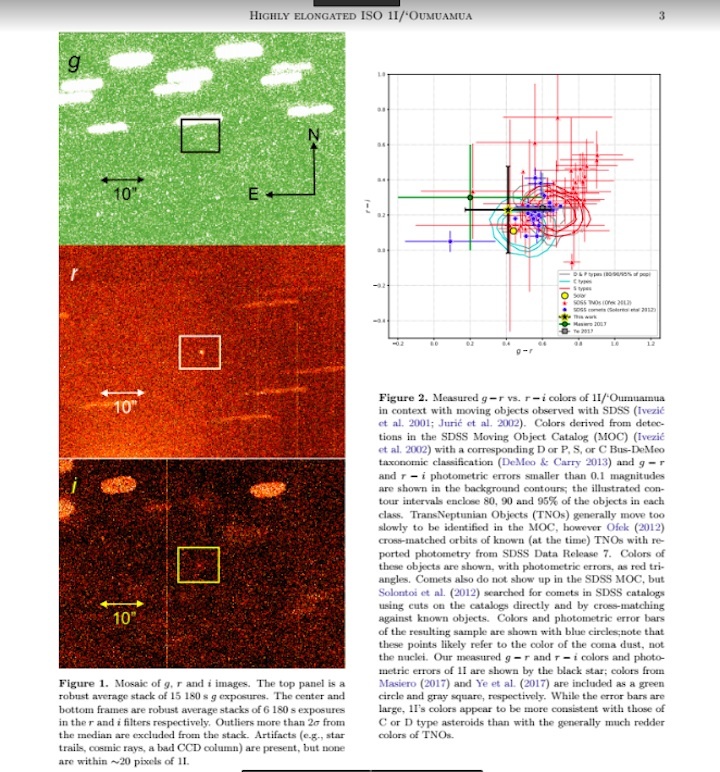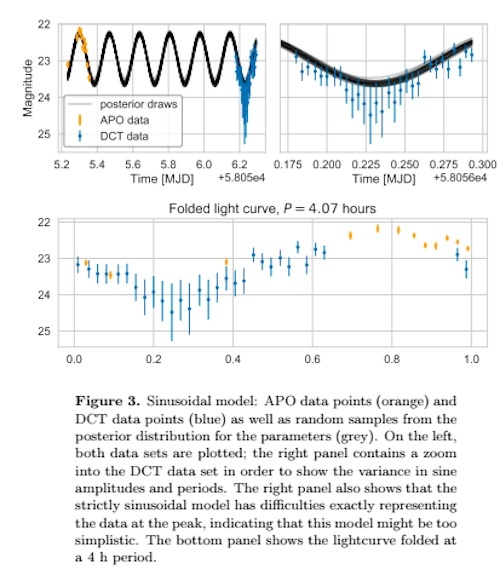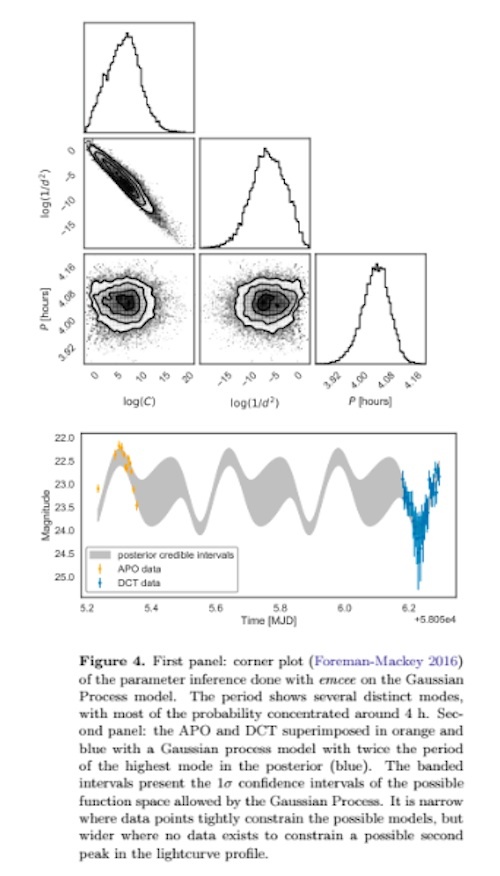10.12.2017
Bryce Bolin, Senior Researcher at B612’s Asteroid Institute, discusses 1I/’Oumuamua, the first interstellar asteroid discovery, and how the Asteroid Institute team is studying it.
‘OUMUAMUA MIA!

More than three weeks ago on October 18, 2017, the first interstellar object (ISO) discovery was made. Initially designated as a comet by the Minor Planet Center, C/2017 U1, the ISO now known as 1I/’Oumuamua was soon discovered not to behave in any way like a comet should, which raised questions about its origins. Initially, the object was thought to originate far outside the solar system in a region known as the Oort cloud where it can have extreme orbits that take them careening through the inner solar system at speeds exceeding 60 km/s. What made the apparition of 1I/’Oumuamua different is that its speed was too high to have a solar system origin. As it was passing within perihelion distance, 1I was moving at 87.7 km/s, about 4.2 km/s too fast for it to be bound to the sun.
The MPC had to give 1I its own special designation because an interstellar object had never been observed before. The last time a non-man made object was seen leaving our solar system was in 1980 with the discovery of comet C/1980 E1 Bowell. C/1980 was not a true interstellar object because it originated inside our solar system and was thrown out of the confines of our Sun’s gravity because of the strong gravitational influence of Jupiter. Given that the existence is so novel, the MPC had to designate it with the number “1” and give it the name meaning “first messenger” in Hawaiian. Maybe 1I is a messenger from another star system, but what can it really tell us about where it came from?
Soon after the discovery of 1I on October 24, a wild race began between astronomers from all around the globe, and my team and I participated in order to obtain telescope data and study I1. Within two days, my fellow researchers and I obtained director’s discretionary time on the Apache Point 3.5 m telescope in Sunspot, New Mexico and obtained images of the asteroid as it passed through the desert skies.
Asteroids have been observed indirectly around other stars, but this was the first opportunity to study a piece from another solar system while it still was in the confines of ours at an unprecedented level of detail. Photometric colors and spectra telling the chemical composition of the surface of 1I were taken, and study revealed that it has a reddish color and probably came from the inner part of its original system where its host star’s heat played an important role in the formation of asteroids and planets. Additionally, the object’s rotation was studied revealing that the object was shaped like a skinny potato.
Below is an image of the object as it crosses the sky and a picture of an asteroid with a similar shape to 1I. There is also a video demonstrating what 1I/’Oumuamua would look like spinning in space.
It’s thought that objects that are elongated have plasticity and are shaped, stretched, and elongated when they encounter the gravity of a planet during a close approach. Does this imply that 1I experienced a gravitationally stretching event before it was ejected from its solar system? Time can only tell as we gather more data. Stay tuned!
My team and I have submitted our observations to The Astrophysical Journal Letters for publication of our results.

Image of 1I/’Oumuamua Asteroid as it Crosses the Sky

Asteroid with a Similar Shape to 1I/’Oumuamua



Quelle: B612
---
Update: 12.12.2017
.
Astronomers to check interstellar body for signs of alien technology
Green Bank telescope in West Virginia will listen for radio signals from ‘Oumuamua, an object from another solar system
Astronomers are to use one of the world’s largest telescopes to check a mysterious object that is speeding through the solar system for signs of alien technology.
The Green Bank telescope in West Virginia will listen for radio signals being broadcast from a cigar-shaped body which was first spotted in the solar system in October. The body arrived from interstellar space and reached a peak speed of 196,000 mph as it swept past the sun.
Scientists on the Breakthrough Listen project, which searches for evidence of alien civilisations, said the Green Bank telescope would monitor the object, named ‘Oumuamua, from Wednesday. The first phase of observations is expected to last 10 hours and will tune in to four different radio transmission bands.
“Most likely it is of natural origin, but because it is so peculiar, we would like to check if it has any sign of artificial origin, such as radio emissions,” said Avi Loeb, professor of astronomy at Harvard University and an adviser to the Breakthrough Listen project. “If we do detect a signal that appears artificial in origin, we’ll know immediately.”
The interstellar body, the first to be seen in the solar system, was initially spotted by researchers on the Pan-Starrs telescope, which the University of Hawaii uses to scan the heavens for killer asteroids. Named after the Hawaiian word for “messenger”, the body was picked up as it swept past Earth at 85 times the distance to the moon.
While many astronomers believe the object is an interstellar asteroid, its elongated shape is unlike anything seen in the asteroid belt in our own solar system. Early observations of ‘Oumuamua show that it is about 400m long but only one tenth as wide. “It’s curious that the first object we see from outside the solar system looks like that,” said Loeb.
The body is now about twice as far from Earth as the sun, but from that distance the Green Bank telescope can still detect transmissions as weak as those produced by a mobile phone. Loeb said that while he did not expect Green Bank to detect an alien transmission, it was worth checking.
“The chances that we’ll hear something are very small, but if we do, we will report it immediately and then try to interpret it,” Loeb said. “It would be prudent just to check and look for signals. Even if we find an artefact that was left over and there are no signs of life on it, that would be the greatest thrill I can imagine having in my lifetime. It’s really one of the fundamental questions in science, perhaps the most fundamental: are we alone?”
The Breakthrough Listen project was launched at the Royal Society in London in 2015, when the Cambridge cosmologist Stephen Hawking announced the effort to listen for signs of life on planets that orbit the million stars closest to Earth. The $100m project is funded by the internet billionaire Yuri Milner, and has secured time on telescopes in the US and Australia to search for alien civilisations.
Astronomers do not have good ideas about how such elongated objects could be created in asteroid belts. By studying ‘Oumuamua more closely, they hope to learn how they might form and whether there are others in the solar system that have so far gone unnoticed. “If it’s of natural origin, there should be many more of them,” Loeb said.
Previous work on the body found it to be extremely dark red, absorbing about 96% of light that falls on it. The colour is associated with carbon-based molecules on comets and asteroids.
If, as expected, the telescope fails to pick up any intelligent broadcasts from ‘Oumuamua, the observations are still expected to aid scientists in understanding the body. Other signals detected by the Green Bank telescope could shed light on whether the object is shrouded in a comet-like cloud of gas, and reveal whether it is carrying water and ice through the solar system.
Quelle: theguardian
+++
BREAKTHROUGH LISTEN TO OBSERVE INTERSTELLAR OBJECT ‘OUMUAMUA
San Francisco – December 11, 2017 – Breakthrough Listen, the global astronomical program searching for evidence of civilizations beyond Earth, announced that it is currently focusing its observational efforts on ‘Oumuamua, the mysterious interloper recently spotted moving rapidly through the solar system.
‘Oumuamua was discovered by the Pan-STARRS project at the University of Hawaii in October 2017, passing Earth at about 85 times the distance to the Moon – a stone’s throw, in astronomical terms. It is the first object discovered in the solar system that appears to originate from another star system. Its high speed – 196,000 mph at its peak – suggests it is not gravitationally bound to the Sun, but will continue its voyage back into interstellar space. It has a highly unusual structure for an asteroid – an elongated cigar shape, hundreds of meters in length but with width and height perhaps only one tenth as long.
Researchers working on long-distance space transportation have previously suggested that a cigar or needle shape is the most likely architecture for an interstellar spacecraft, since this would minimize friction and damage from interstellar gas and dust. While a natural origin is more likely, there is currently no consensus on what that origin might have been, and Breakthrough Listen is well positioned to explore the possibility that ‘Oumuamua could be an artifact.
Listen’s observation campaign will begin on Wednesday, December 13 at 3:00 pm ET. Using the Robert C. Byrd Green Bank Telescope, it will continue to observe ‘Oumuamua across four radio bands, from 1 to 12 GHz. Its first phase of observations will last a total of 10 hours, divided into four “epochs” based on the object’s period of rotation.
‘Oumuamua is now about 2 astronomical units (AU) away, or twice the distance between Earth and the Sun. This is closer by a factor of 50-70 than the most distant human artifact, the Voyager I spacecraft. At this distance, it would take under a minute for the Green Bank instrument to detect an omnidirectional transmitter with the power of a cellphone.
“‘Oumuamua’s presence within our solar system affords Breakthrough Listen an opportunity to reach unprecedented sensitivities to possible artificial transmitters and demonstrate our ability to track nearby, fast-moving objects,” said Listen’s Andrew Siemion, Director of Berkeley SETI Research Center. “Whether this object turns out to be artificial or natural, it’s a great target for Listen.”
Even if no signal or other evidence of extraterrestrial technology is heard, Listen observations will cover portions of the radio spectrum in which the object has not yet been observed, and could provide important information about the possibility of water/ice, or the chemistry of a coma (gaseous envelope), neither of which have yet been identified. Listen has already proved its value for traditional, non-SETI astronomy: in August 2017 it detected several dozen repeating fast radio bursts (FRBs) from a distant dwarf galaxy – for details see www.astronomerstelegram.org/?read=10675.
Breakthrough Listen is a scientific program in search for evidence of technological life in the Universe. It aims to survey one million nearby stars, the entire galactic plane and 100 nearby galaxies at a wide range of radio and optical bands.
The Breakthrough Initiatives are a suite of scientific and technological programs exploring the Universe, seeking scientific evidence of life beyond Earth, and encouraging public debate from a planetary perspective.
Quelle: Breakthrough Initiatives
+++
Astronomers to Check Mysterious Interstellar Object for Signs of Technology
Russian billionaire Yuri Milner says if the space rock 'Oumuamua is giving off radio signals, his team will be able to detect them—and they may get the results within days.
The email about “a most peculiar object” in the solar system arrived in Yuri Milner’s inbox last week.
Milner, the Russian billionaire behind Breakthrough Listen, a $100 million search for intelligent extraterrestrial life, had already heard about the peculiar object. ‘Oumuamua barreled into view in October, the first interstellar objectseen in our solar system.
Astronomers around the world chased after the mysterious space rock with their telescopes, collecting as much data as they could as it sped away. Their observations revealed a truly unusual object with puzzling properties. Scientists have long predicted an interstellar visitor would someday coast into our corner of the universe, but not something like this.
“The more I study this object, the more unusual it appears, making me wonder whether it might be an artificially made probe which was sent by an alien civilization,” Avi Loeb, the chair of Harvard’s astronomy department and one of Milner’s advisers on Breakthrough Listen, wrote in the email to Milner.
A day later, Milner’s assistant summoned Loeb to Milner’s home in Palo Alto. They met there this past Saturday to talk about ‘Oumuamua, a Hawaiian word for “messenger.” Loeb ran through the space rock’s peculiarities, particularly its elongated shape, which looks like a cigar or needle—an odd shape for a common space rock.
For Milner, the object was becoming too intriguing to ignore. So he’s decided to take a closer look.
Breakthrough Listen announced Monday that the program will start checking ‘Oumuamua this week for signs of radio signals using the Green Bank Telescope in West Virginia. The interstellar asteroid is now about twice the distance between the Earth and the sun from our planet, moving at a brisk clip of 38.3 kilometers per second. At this close distance, Green Bank can detect the faintest frequencies. It would take the telescope less than a minute to pick up something as faint as the radio waves from a cellphone. If ‘Oumuamua is sending signals, we’ll hear them.
The chance of an alien detection is, as always, small. But it’s not zero. And Milner thinks we should check—just in case—before ‘Oumuamua is gone for good. The object will pass the orbit of Jupiter next year, and by the 2020s will be hurtling beyond Pluto.
“Whether it’s artificial or not, we will definitely know more about this object,” Milner told me, in a video interview last week.
The new observations will likely be welcomed by the many astronomers who have been scratching their heads for weeks over this space rock. ‘Oumuamua seems to smash many of their predictions about fast-moving interstellar objects, and the more scientists delve into the data, the more puzzles they find.
The glint of ‘Oumuamua was first spotted by the Pan-STARRS survey telescope in Hawaii during its nightly scan of near-Earth objects like comets and asteroids. Its speed and orbit suggested the object was not bound by the sun’s gravity, and was not of this solar system.
At first, astronomers thought ‘Oumuamua must be a comet, based on decades of scientific literature that predicted its arrival. When our solar system was young, the biggest planets wreaked havoc as they swirled into shape and settled into their orbits. Their movements could jostle nearby material so violently that bits of rock and ice would go flying way out into the universe. The easiest objects to eject were those orbiting at the edge of the solar system, where escaping from the sun’s gravity would be easier. In our solar system, there are far more comets than asteroids lurking near the boundary before interstellar space. Astronomers expected these to be the first interstellar objects they saw.
And so astronomers checked ‘Oumuamua for a coma, a tail of evaporated material that trails comets as they pass near the sun and become heated up. They used telescopes that can detect a sugar cube’s worth of material flying off the object every second. But ‘Oumuamua showed no signs of a coma.
This was the first surprise of many.
Unlike the lumpy, potato-shaped asteroids of our solar system, the 400-meter-long ‘Oumuamua is perhaps 10 times as long as it is wide, an extreme aspect ratio that trumps any of the known asteroids. Astronomers don’t know how the universe could have produced an object such as this. Most natural interactions between an object and its surrounding medium favor the creation of rounded objects, Loeb said, like pebbles on a lakeshore made smooth by lapping water.
Further observations of ‘Oumuamua revealed it carried no traces of water ice, which suggests the asteroid is made of rock or perhaps metal. Whatever it is, the material is certainly sturdy. ‘Oumuamua rotates about every seven hours, a rate that would likely cause some rocky objects, nicknamed “rubble piles,” to crumble. ‘Oumuamua even survived a close pass with the sun in September, before it was detected, without breaking apart.
Thanks to its nonspherical shape, the asteroid is tumbling uncontrollably. “If you take an object that isn’t round and you throw it up in the air, it’ll make this complicated spinning motion,” said Jason Wright, an astronomer at Penn State University. “It just doesn’t just spin nicely along one axis.” Wright said a long journey across the cosmos can slow an object’s tumbling, but ‘Oumuamua has shown no signs of stopping its spinning.
“I’m not saying that any of that is necessarily a smoking gun or super exciting,” Milner said of ‘Oumuamua’s unusual properties. “But I think it warrants thorough investigation from a seti standpoint.”
Karen Meech, an astronomer at the University of Hawaii Institute for Astronomy whose team discovered ‘Oumuamua, has said their observations are “entirely consistent with it being a natural object.” Analysis of the light reflected by the asteroid shows ‘Oumuamua is red, a color that would be expected for rocky bodies exposed to the cosmic radiation of interstellar space for long periods of time.
There are indeed some natural explanations for some of ‘Oumuamua’s weird properties. Some astronomers say ‘Oumuamua could be a contact binary—two objects that drift closer until they touch and fuse at one end—like our solar system’s Kleopatra, a metallic, dog-bone-shaped asteroid.
They suggest any ice on the asteroid’s surface was zapped away by high-energy particles on its journey between stars. Perhaps the asteroid is so hardy because it formed in the inner regions of a solar system, where rock and metal are more commonly found than ice. This would be tricky, since most exoplanets discovered so far orbit extremely close to their parent star, preventing them from flinging debris beyond the star’s pull. But they may have siblings, like our Jupiter and Neptune, lurking in the darkness, doing the work for them.
If ‘Oumuamua has anything exciting to tell us, it’s that our understanding of planet formation needs some work, said Gregory Laughlin, an astronomer who studies exoplanets at Yale University.“We know that planetary systems are extremely common, but the way that their process unfolds seems to be richer than anticipated,” he said.
The thought of a spaceship being dropped into planetary systems like a reconnaissance mission may sound like the stuff of science fiction. But for Milner, it’s the future. Milner is spending $100 million over 10 years to develop spacecraft technology capable of sending a tiny probe hurtling at one-fifth the speed of light toward Alpha Centauri, the nearest star system to Earth. If Milner succeeds, the 25-trillion-mile trip would be cut from tens of thousands of years, based on our current technology, to a breezy 20 years. Hundreds of these miniature probes would be deployed into the darkness in the hopes that at least one might complete the journey. Perhaps another civilization already had the same idea.
If that kind of technology were available today, Milner said he would send some kind of probe after ‘Oumuamua. “We need some new propulsion technologies to be able to do this,” he said.
The possibility that ‘Oumuamua is an artificial artifact from an advanced civilization is not spoken in whispers in the astronomy community. But there’s a healthy dose of hesitation in their discussions. Scientists must, after all, exhaust every other plausible explanation before considering ET.
“It’s sometimes mentioned in a half-joking way that people say things when they’re not quite sure whether they want you to take them seriously or not,” said Ed Turner, an astrophysicist at Princeton University. He’s intrigued by a potential seti observation of ‘Oumuamua, but, like most astronomers, he’s not holding his breath.
“If you were betting your house, I wouldn’t bet it on this,” Turner said.
When they speak of ‘Oumuamua, astronomers recall the tale in Arthur C. Clarke’s 1973 novel Rendezvous with Rama. The year is 2131, and astronomers have detected a mysterious object beyond the orbit of Jupiter and classified it as an asteroid. Their observations reveal the object, named Rama, doesn’t follow the orbit of the sun and must have come from outside the solar system. They send a space probe to photograph Rama and find it’s in the shape of a perfect cylinder. A crewed mission is dispatched. When they land, humans discover the asteroid is an alien spaceship, carrying odd, machinelike beings that pay them little attention. There are no signs of the alien civilization that made them. After some tinkering, the human crew disembarks, leaving Rama to speed out of the solar system.
The story shares some tantalizing similarities with the current circumstances. The most skeptical astronomers point out that, aside from its vessel-like shape, ‘Oumuamua doesn’t have any of the characteristics one would imagine for an alien spacecraft. The object has followed an easy-to-predict trajectory through the solar system. Astronomers have accurately plotted its course forward and backward. Wouldn’t an alien spaceship travel at a fraction of the speed of light, and wouldn’t it slow down to take a look at things as it swept by?
“The explanation that this is a directed probe is, in my view, comically unlikely,” said Konstantin Batygin, a planetary astrophysicist at the California Institute of Technology. “This is just a chunk of debris. I think there’s nothing more to it than that.”
Astronomers predict many more interstellar asteroids, perhaps thousands, are coasting through our solar system, out of view of our telescopes. Pan-STARRS, a survey telescope designed to observe the entire visible sky night after night, found ‘Oumuamua after only four years of operation. Turner suspects the discovery—a fairly quick one—is not a case of pure luck, but a sign of more to come.
Some interstellar asteroids may be hiding, overlooked, in the archival data of Pan-STARRS. Many more will be spotted as other powerful survey telescopes, like the Large Synoptic Survey Telescope in Chile, come online in the next few years.
For Milner, it’s worth examining every interstellar object for signs of artificial technology. They could all be nothing more than space rocks, mindlessly plowing ahead. Or they could be the needle in the haystack. “It would be difficult to work in this field if you thought that every time you looked at something, you weren’t going to succeed,” said Andrew Siemion, the director of the Berkeley setiResearch Center who leads the center’s Breakthrough Listen Initiative.
And so, starting Wednesday at 3 p.m. Eastern Time, the Green Bank Telescope will aim at the first known interstellar object in our solar system. The telescope will observe the asteroid for 10 hours across four bands of radio frequency. The results may be made public within a matter of days.
Milner knows the odds are against him. But as he spoke from a conference table in his home, flanked by screens filled with radiant telescope images stretching from floor to ceiling, he smiled in excitement.
“If you look more, everywhere, I think chances are that eventually you will find something,” he said.
Quelle:The Atlantic
